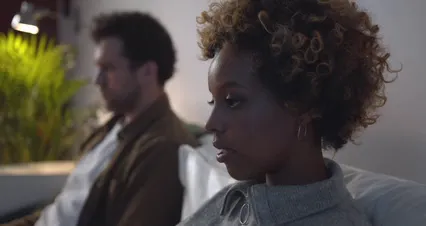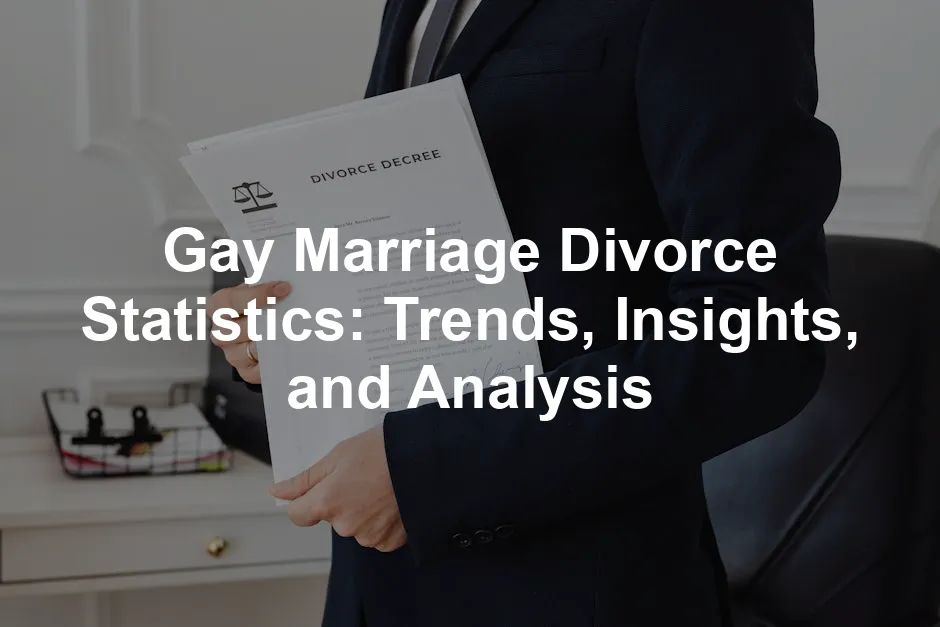Introduction
Same-sex marriage has come a long way since its early days. The legalization of same-sex marriage has transformed not only the lives of countless couples but also the landscape of relationships in society. In the United States, landmark rulings like Obergefell v. Hodges in 2015 made marriage equality a reality, allowing same-sex couples to enjoy the same rights and privileges as heterosexual couples.
However, with marriage comes the potential for divorce. Understanding divorce statistics within same-sex marriages is crucial for grasping the dynamics at play in these relationships. While the focus often lies on the joy of marriage, it’s essential to consider the challenges that can arise when things don’t go as planned.
This article aims to explore current statistics on gay marriage divorce, analyze differences between lesbian and gay male couples, and discuss possible factors influencing these trends. By examining the data, we aim to shed light on the unique experiences of same-sex couples in the context of marriage and divorce, offering insights that can inform future couples and policymakers alike.
For those interested in diving deeper into the nuances of same-sex marriage, consider picking up Same-Sex Marriage: A Historical Perspective. This book offers a thoughtful examination of the events that led us to where we are today, perfect for those curious about the journey of love and legality.

The Legal Landscape of Same-Sex Marriage and Divorce
Historical Context
The journey toward same-sex marriage legalization has been marked by significant milestones. It began with the Netherlands, which became the first country to legalize same-sex marriage in 2001. The U.S. followed suit more than a decade later, with Massachusetts leading the charge in 2004. The landmark Supreme Court ruling in United States v. Windsor (2013) paved the way for federal recognition of same-sex marriages. Then came the game-changer: Obergefell v. Hodges (2015) declared that same-sex couples have the right to marry nationwide, ensuring equality in marriage rights.
These legal advancements opened the doors to countless same-sex unions, but they also introduced new complexities, particularly in the realm of divorce. Divorce for same-sex couples can be fraught with challenges, especially if they reside in states that do not recognize their marriage. For instance, prior to 2015, couples who married in a progressive state might find themselves in legal limbo if they moved to a more conservative state that did not recognize their union.
With the establishment of marriage equality, same-sex couples can now legally divorce in any state. However, the implications of divorce laws can still vary widely based on state legislation. This legal patchwork creates a unique situation for same-sex couples navigating the dissolution of their marriages, further complicating the statistics surrounding their divorce rates.
As we move forward, it’s essential to understand how these historical and legal contexts shape the current landscape of same-sex marriage and divorce. By examining the nuances of the law, we can better comprehend the trends and insights related to divorce statistics among same-sex couples.
If you’re looking for a comprehensive guide to navigate these complexities, check out The Marriage Equality Movement: A Global Perspective. This book provides a broad overview of marriage equality efforts worldwide, helping you appreciate the global context of these changes.

Current Legal Status
Same-sex marriage holds varying legal recognition across the globe. In many progressive countries, like the Netherlands and Canada, same-sex unions are fully embraced. However, in some regions, these marriages face significant hurdles. In many conservative jurisdictions, legal recognition remains elusive. This discrepancy creates unique challenges for couples seeking to dissolve their marriages.
For same-sex couples, divorce can be complicated by jurisdictional issues. In the U.S., for example, marriage and divorce laws are state-specific. After the historic Obergefell v. Hodges ruling in 2015, same-sex couples gained the right to marry nationwide. Yet, state laws can still create obstacles during divorce proceedings. Couples who move from a state that recognizes their marriage to one that doesn’t may face legal limbo. Such challenges can lead to complex legal disputes, especially regarding property rights and custody arrangements.
Understanding these legal nuances is crucial. The landscape of same-sex marriage and divorce is still evolving. Couples navigating divorce must be mindful of the specific laws in their state to avoid a legal quagmire.
To help navigate these complex waters, Same-Sex Divorce: A Practical Guide is a valuable resource that offers insights and practical steps for couples facing divorce, ensuring they understand their rights and options.

Understanding Divorce Statistics in Same-Sex Marriages
General Statistics
The divorce rates among same-sex couples reveal intriguing patterns. According to studies conducted by the Williams Institute, the divorce rate for same-sex couples is approximately 1.1% annually. This rate is slightly lower than the 2% rate observed among heterosexual marriages. However, these statistics are still relatively new, given that same-sex marriage has only been legal for a short time in many regions.
Interestingly, the divorce rate varies significantly between different demographics. In the UK, 72% of same-sex divorces involve lesbian couples, highlighting a stark contrast to their gay male counterparts. This discrepancy raises questions about the dynamics within same-sex marriages and societal expectations.
Comparing these statistics to heterosexual marriages provides valuable insights. For instance, while the overall divorce rate among heterosexual couples is about 50%, same-sex couples experience lower rates. This difference may stem from various factors, including the emotional and legal significance of same-sex marriage.
To better understand these dynamics, consider reading The LGBT Marriage Debate: A Comprehensive Guide. This book delves into the various arguments and perspectives surrounding marriage equality, enriching your understanding of the topic.

Breakdown by Gender
Lesbian Couples
When examining divorce rates, it becomes evident that lesbian couples face higher rates of dissolution. In the UK, 72% of same-sex divorces are initiated by lesbian couples. This trend has emerged consistently over the years, with data showing that women tend to file for divorce more frequently than men. In 2016, the divorce rate among lesbian couples stood at 78%, subsequently dropping to 74% in 2017.
Several factors contribute to this phenomenon. One potential reason is the societal expectation for women to seek emotional fulfillment in their relationships. Lesbians often face pressures related to commitment and relationship satisfaction. The “U-Haul phenomenon,” a humorous yet poignant term, describes how many lesbians tend to move in together quickly, sometimes without fully understanding their compatibility. This rush can lead to conflicts down the line.
Additionally, relationship dynamics play a significant role. Reports indicate that lesbian couples may experience a higher incidence of conflict and dissatisfaction, particularly when expectations are not met. Factors such as unequal relationship dynamics, communication issues, and differing aspirations contribute to the higher divorce rates observed among lesbian couples.
For those wanting to enhance their relationships, Relationship Goals: How to Build a Healthy Same-Sex Marriage can provide you with essential tips and strategies to foster a lasting partnership.

Gay Male Couples
When examining divorce rates among same-sex couples, gay male couples tend to have lower rates than their lesbian counterparts. Recent statistics reveal that approximately 28% of same-sex divorces involve gay men. This contrasts sharply with the higher figure of 72% for lesbian couples. One possible explanation for this disparity is the nature of commitment levels among gay couples. Many studies suggest that gay men often approach relationships with a strong sense of partnership and mutual respect.
Additionally, relationship satisfaction may be a contributing factor. Gay male couples frequently report higher levels of relationship contentment compared to lesbian couples. This might stem from more egalitarian dynamics, where both partners contribute equally to the relationship. With lower instances of conflict, it’s no wonder that gay men are less likely to seek divorce.
For couples looking to enhance their communication skills, consider reading The Art of Communication in Relationships. This book offers insights on how to communicate effectively, which can be a game-changer for maintaining harmony in your relationship.

Case Studies
To better illustrate these trends, let’s consider some case studies. In one notable study from the UK, a gay male couple married for five years reported a strong commitment to each other, citing open communication as essential to their relationship. They found that discussing issues openly led to significant improvements in their connection, reducing misunderstandings.
In contrast, a lesbian couple married for three years faced challenges due to differing expectations around household responsibilities. This misalignment led to frustration and ultimately contributed to their decision to divorce. Such examples highlight how relationship dynamics can directly influence divorce rates in same-sex marriages.

Factors Influencing Divorce Rates
Relationship Dynamics
The dynamics within gay male couples often differ from those in lesbian couples, significantly affecting divorce rates. Research indicates that gay men tend to establish clearer roles within their relationships. This clarity can lead to a more stable partnership, as both partners know what to expect from each other. In contrast, lesbian couples frequently face challenges related to communication and expectations. Studies show that when women are involved, relationship dynamics can become more complex, leading to misunderstandings and dissatisfaction.
Moreover, the expectation for emotional fulfillment can weigh heavily on lesbian couples. They might hold each other to higher standards, resulting in a greater likelihood of disappointment. This disparity in relationship dynamics is critical to understanding the differences in divorce rates.

Societal Expectations and Pressures
Societal norms also play a significant role in shaping divorce rates. Lesbian couples often face greater societal pressures, which may contribute to their higher divorce rates. These pressures can stem from traditional views on relationships or unrealistic portrayals of same-sex partnerships in media. Consequently, lesbian couples might feel compelled to meet certain expectations, leading to stress and dissatisfaction.
In contrast, gay male couples may benefit from a more supportive environment. Many gay men find community support that encourages stability in their relationships. This support can mitigate the impact of societal expectations, allowing them to focus on their partnership rather than external pressures. The contrasting societal experiences of lesbian and gay male couples can significantly influence their respective divorce rates.

Commitment Levels
Commitment is the backbone of any marriage. In same-sex unions, commitment levels vary. Studies show that gay male couples often demonstrate stronger commitment compared to lesbian couples. Research by the Williams Institute reveals that many gay men view their partnerships as a serious, lifelong commitment. This perspective likely contributes to their lower divorce rates. On the flip side, lesbian couples may enter relationships with heightened emotional expectations. Often, they feel pressured to create deeply fulfilling partnerships. This pressure can lead to dissatisfaction and, ultimately, divorce.
Moreover, the “U-Haul phenomenon” illustrates how quickly some lesbians move in together. This rush can cloud judgment about compatibility, leading to issues down the road. The emotional intensity can be a double-edged sword, fostering attachment but also increasing the likelihood of conflict. In summary, commitment shapes the stability of same-sex marriages, with varying dynamics influencing outcomes based on gender.

Impacts of Parenthood
Parenthood introduces unique dynamics into any relationship, and same-sex couples are no exception. For lesbian couples, parenting can heighten stress levels, significantly impacting divorce rates. Research indicates that lesbian couples face challenges related to co-parenting, which may lead to conflicts. The study from the Journal of Family Psychology highlights that parenting older children introduces stressors that can strain relationships.
In contrast, gay male couples often report a more collaborative parenting approach. They tend to share parenting responsibilities more equally, which may reduce tension. This division of labor can create a supportive environment, ultimately making the relationship stronger. However, when issues arise, such as disagreements on parenting styles, the potential for conflict increases. Thus, while parenthood can strengthen bonds, it can also challenge the stability of same-sex marriages, often leading to increased divorce rates among lesbian couples.

Economic Factors
Financial stability plays a crucial role in the longevity of marriages. For same-sex couples, economic factors can influence divorce rates significantly. Research suggests that economic inequalities often affect lesbian couples more than gay male couples. Many same-sex female couples may face wage gaps or job instability, which can lead to stress and conflicts.
On the other hand, gay male couples generally report higher collective incomes. This financial advantage can provide a buffer against the stressors that often lead to divorce. Studies have shown that financial security contributes to greater relationship satisfaction. Couples who are financially stable tend to have lower divorce rates, regardless of sexual orientation. Thus, economic factors are not just about income levels; they also encompass the stress and strain that financial instability can impose on relationships. In the context of same-sex marriages, these disparities can have significant implications for divorce rates.
For those planning their financial future together, Financial Planning for Same-Sex Couples is a must-read. This book provides essential insights into managing finances as a couple, helping you build a secure future together.

Australia and Other Regions
Since the legalization of same-sex marriage in Australia in 2017, divorce rates have started to emerge, unveiling intriguing trends. In 2021, the Australian Bureau of Statistics reported 473 same-sex divorces, with 306 involving female couples and 167 involving male couples. This marked a significant milestone as it was the first year that data on same-sex divorces was published.
Interestingly, the number of same-sex marriages registered in 2021 was 2,842, showcasing that female couples are more likely to marry compared to their male counterparts. In fact, female couples constituted 62% of same-sex marriages that year. However, the divorce statistics suggest that the breakdown rates for same-sex marriages are beginning to resemble those of heterosexual unions.
The average marriage duration before divorce was about 8.5 years, which indicates a healthy period of commitment for many couples. Former MP Tim Wilson humorously noted that same-sex couples could also share the experience of “miserable marriages” that heterosexual couples often face. This indicates that the challenges of marriage are universal, regardless of sexual orientation.
As the same-sex marriage landscape continues to evolve, it will take time for divorce rates to stabilize and yield statistically significant insights. The story of same-sex marriage in Australia reflects broader societal shifts towards acceptance and equality. Now, couples can not only celebrate love but also navigate the complexities of marriage, including the possibility of divorce, just like everyone else.

Conclusion
The statistics surrounding gay marriage divorce reveal a complex yet fascinating picture. A significant takeaway is that lesbian couples tend to file for divorce more frequently than gay male couples. In the UK, for example, around 72% of same-sex divorces involved lesbian couples. This trend is consistent with findings from other regions, including Australia, where the divorce rates are beginning to mirror those of heterosexual couples.
Understanding these statistics is crucial for same-sex couples contemplating marriage. The trends suggest that while marriage can be a fulfilling journey, it also comes with challenges. For couples considering tying the knot, it’s essential to recognize the potential for conflict and to prioritize open communication from the start. Navigating a marriage requires dedication, understanding, and sometimes, a willingness to seek help.
Furthermore, these statistics underscore the importance of discussing relationship dynamics openly. Many same-sex couples may face unique challenges rooted in societal expectations and personal aspirations. Engaging in conversations about these dynamics can foster healthier relationships.
For those looking for expert advice, Marriage Advice from Experts: A Compilation can provide invaluable insights to help couples navigate their journey.

As marriage equality continues to evolve, it is vital to embrace the realities of both love and conflict. Couples should not shy away from discussing their expectations and the potential difficulties they might encounter. By doing so, they can strengthen their relationships and build a more supportive environment, ultimately leading to more fulfilling unions.
FAQs
Understanding the divorce statistics in California can provide valuable insights into the broader trends affecting same-sex couples.
What are the general divorce rates for same-sex couples?
Recent studies show that around 1.1% of same-sex marriages end in divorce annually, which is slightly lower than the 2% average for heterosexual couples. In the UK, approximately 72% of same-sex divorces involve lesbian couples, indicating a higher tendency to file for divorce among women in same-sex unions.
Why do lesbian couples have higher divorce rates than gay male couples?
Several factors contribute to this trend. Lesbian couples often experience higher expectations regarding emotional fulfillment and relationship dynamics. The rapid pace at which many lesbian couples commit, sometimes referred to as the “U-Haul phenomenon,” can lead to conflicts when compatibility issues arise. Additionally, societal pressures and different approaches to conflict resolution may also play a role.
How do divorce rates among same-sex couples compare to heterosexual couples?
On average, same-sex couples experience lower divorce rates compared to heterosexual couples. While approximately 50% of heterosexual marriages end in divorce, same-sex couples have shown a tendency toward more stable unions in the early years of legalization. However, the statistics indicate that these rates may equalize as more same-sex couples marry and navigate the complexities of partnerships.
What are some common reasons for divorce among same-sex couples?
Common reasons for divorce among same-sex couples include emotional dissatisfaction, lack of communication, and differing expectations. Specific issues like unequal shared responsibilities and external societal pressures can also exacerbate tensions. For lesbian couples, infidelity and unmet emotional needs are frequently cited as contributing factors to divorce.
Are divorce rates among same-sex couples expected to change in the future?
Future trends in divorce rates among same-sex couples will likely reflect broader societal attitudes towards marriage and relationships. As same-sex couples continue to navigate the complexities of marriage, ongoing discussions about relationship dynamics and individual expectations will be crucial. Legal recognition and societal acceptance may influence the stability of these marriages, potentially leading to more balanced divorce rates over time.
Please let us know what you think about our content by leaving a comment down below!
Thank you for reading till here 🙂
All images from Pexels




